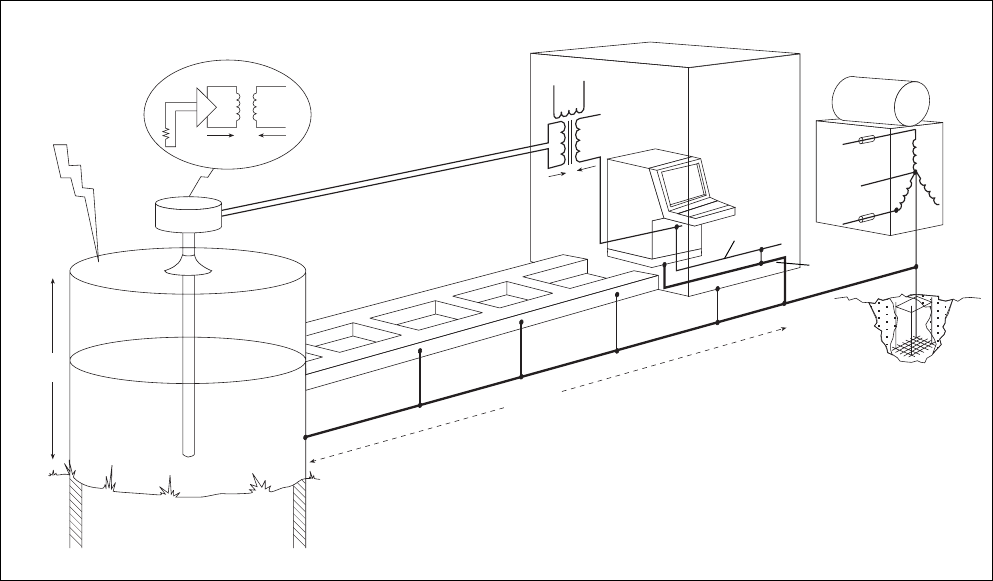
SURGE SUPPRESSION FOR
ZONE 0 LOCATIONS
tal requirement of all the methods of protection used for power equip-
ment. It is not usual for lightning induced current to directly cause enough
heating to create a hazard by temperature ignition, since the current
pulses are too short to create a sustained high temperature. However,
vapourisation of flimsy conductors such as printed circuit tracks is not
unusual. Overheating may occur if there is a power follow through of
a fault initiated by the lightning induced voltage. It can be argued that
if intrinsically safe apparatus is likely to be subjected to lightning dam-
age then it is necessary to protect it since, following the lightning dam-
age, its intrinsic safety may be impaired. There is no requirement in the
apparatus standard to consider the effect of excessive surges, which
are difficult to predict and could lead to damage. The problem should
not be exaggerated, since lightning damage usually results in failure
to a safe condition and also to operational failure and hence should
be noticed and corrected. Possibly the need to repair or remove non-
functional electrical equipment needs to be given further emphasis in
the code of practice.
It is accepted that transient hazards during infrequent electrical faults
can occur in Zones 1 and 2 providing that they are removed as quickly
as is practical. The argument being that the coincidence of the poten-
tially hazardous electrical fault and a flammable mixture of gas is suf-
ficiently improbable to be acceptable. In the particular case of light-
ning a similar analysis suggests that transient hazards caused by points
of lightning impact and the occasional failure to bond adequately are
possibly acceptable in Zone 1 and 2 but not acceptable in Zone 0.
Fortunately the majority of Zone 0 locations are contained within proc-
ess vessels which form an adequate Faraday cage which effectively
prevents significant potential differences within the Zone 0 and hence
the problem is generally controllable. Where problems are known to
exist then special precautions are taken, for example the bond be-
tween the floating roof of a storage tank and the tank itself is designed
with considerable care, and subjected to frequent inspections. A prob-
lem is introduced when the Faraday cage of the Zone 0 is broken by
the introduction of equipment for measurement purposes.
Figure 1 shows an average contents temperature gauge being used in
a storage tank and this illustrates the problem. The potential equalising
network is shown diagramatically as a substantial structure intercon-
nected electrically, in practice it is the plant structure bonded together.
The transmitter protruding from the tank top is intended to illustrate the
concept. In practice in a high lightning activity area it would be unwise
to have the equipment protruding from the tank in this way since it
would possibly invite a direct strike and could be the natural source of
corona discharge. It should be provided with some mechanical protec-
1 INTRODUCTION
For many years there has been general recognition that there is a
significant problem from lightning strikes on installations such as stor-
age tanks. The codes of practice for instrumentation in hazardous ar-
eas for Germany and Holland both contain recommendations for spe-
cific installation practice. In the United Kingdom the code of practice
contains no detailed requirements and the problem has always been
approached on an individual installation basis. Perhaps the clearest
references are in the draft revision of the IEC code which contains two
specific references to lightning problems. These, together with the rel-
evant clause on potential equalisation, are quoted in full as an appen-
dix (clauses 6.3, 6.5 and 12.3).
Although this code of practice has not yet been finally voted on and
published it is likely to form the basis of accepted practice in signifi-
cant parts of the world and forms a convenient reference document.
When a plant is struck by lightning then the point of impact would
inevitably ignite a gas and air mixture that was present. Ignition at
points other than the point of impact are dependent on the efficiency of
bonding which must be adequate to prevent side flashes and hence
bonding should have a low impedance as well as a low resistance.
The majority of petrochemical installations are adequately bonded and
sufficiently robust to prevent excessive lightning damage although some
side flashes usually occur following a significant adjacent strike. Co-
rona discharge from structures does occur in some atmospheric condi-
tions and multiple streamers rising from structures to meet the usual
lightning downward leader (which selects one of them) are a well es-
tablished phenomenon. It is possible that if either a lightning flash, an
upward corona streamer, or a side flash pass through a flammable
mixture of gas then ignition will occur. In general, conventional bond-
ing of a plant is considered adequate and the implications of possible
lightning impact points are not considered a significant problem ex-
cept in the case of vents which frequently discharge. Where lightning
can damage the electrical insulation of power circuits there is a tran-
sient potential hazard caused by the follow through of the power cir-
cuit. This should however be rapidly removed by the electrical protec-
tion ie. fuses, out of balance circuit breakers etc. which is a fundamen-
10m
0.1µH/m
(10kV)
100kA
10µS
30KV
L
1
L
2
30kV
Potential equalising
network
0.1µH/m
10kA
500m
(50kV)
Computer 0V
Power 0V
1
Figure 1 Installation without surge protection










